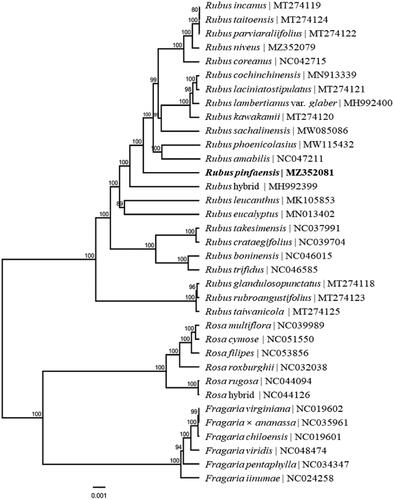Abstract
Rubus pinfaensis H. Lév. & Vaniot is of great importance in the phylogeny and evolution amongst Rosaceae, genus Rubus L. plants. The chloroplast genome of R. pinfaensis was reported in this study, which is 155,523 bp in size, with an average GC content of 37.13%. The complete chloroplast genome has a typical quadripartite structure, including a large single copy (LSC) region (85,211 bp) and a small single copy (SSC) region (18,718 bp), which were separated a pair of inverted repeats (IRs, 25,797 bp). This plastome contained 129 different genes (112 unique), including 85 protein-coding genes (79 unique), 36 tRNA genes (29 unique), and 8 rRNA genes (4 unique). The chloroplast genome of R. pinfaensis has completed that will be based on the phylogeny and genomic studies in the family Rosaceae, genus Rubus L.
Rubus pinfaensis H. Lév. & Vaniot belong to genus Rubus L. section Idaeobatus Focke, Subsection Pungentes (Focke) Yu et Lu in the family Rosaceae, widely distributed in Hubei, Hunan, Taiwan, Guangxi, Sichuan, Yunnan and Guizhou province in China (Robertson Citation1974; Yu and Lu Citation1985; Thompson Citation1995; Lu and Boufford Citation2003). The fresh golden or orange fruits can be used for food, vinting (making wine) and medicine, and the roots and leaves can also be used for medicine. For the reasons of inter- and intraspecific hybridization, polyploidization and apomixis, it is extremely difficult in species delimitation in genus Rubus L. because of the complexity of their morphological variations (Alice and Campbell Citation1999), especially with R. ellipticus Smith. Therefore, it is essential to reconstructing phylogeny based on sufficient molecular markers if the relationship between species want to be well understood, for the sake of efficiently utilizing these wild Rubus germplasm resources in raspberry hybrid breeding. In this study, we reported the complete chloroplast genome of R. pinfaensis, a wild species widespread in temperate zone, subtropical and tropical China, with elevation between 500 and 2200 m, as a resource for future studies on the taxonomy of Rubus L.
The complete sequence of chloroplast genome of R. pinfaensis was reported in this study. The fresh leaves of R. pinfaensis were collected from Cuihua Town, Daguan County, Zhaotong City, Yunnan Province of China (27°45′14″ N, 103°53′51″ E). The sheets of vouchered specimen, Zhu-20201014R04, are stored at the herbaria HHP-YNAU (Herbarium of Horticultural plants, College of Landscape and Horticulture, Yunnan Agricultural University). Total genomic DNA was extracted from fresh leaves by using DNA Plantzol Reagent (Invitrogen, Carlsbad, CA, USA) to construct chloroplast DNA libraries. The extracted DNA was sequenced by Illumina HiSeq Sequencing System (Illumina, San Diego, CA) and shotgun library was constructed. About 2.42 Gb pair-end (150 bp) raw reads were obtained and the low-quality sequences were filtered using CLC Genomics Workbench v8.0 (CLC Bio, Aarhus, Denmark) to get high-quality clean reads. NOVOPlasty software (Dierckxsens et al. Citation2017) was used to align and assemble cp genome with R. niveus Thunb (MT576936) served as the reference. The complete chloroplast genome of R. pinfaensis was automatically annotated using CpGAVAS (Liu et al. Citation2012) and then adjusted and confirmed with Geneious 9.1 (Kearse et al. Citation2012). The sequence data was deposited into GenBank. Then the complete chloroplast genome was submitted to the GenBank under the accession number of MZ352081.
The size of chloroplast genome of R. pinfaensis is 155,523 bp, with an average GC content of 37.13%, which exhibited a typical quadripartite structure comprising a large single-copy (LSC) region of 85,211 bp and a small single-copy (SSC) region of 18,718 bp separated by a pair identical inverted repeat regions (IRs) of 25,797 bp each. The chloroplast genome contains 129 genes (112 unique), including 85 protein-coding genes (79 unique), 36 tRNA genes (29 unique), and 8 rRNA genes (4 unique).
The ML phylogenetic tree shows that R. pinfaensis and other 22 species of genus Rubus L. formed a monophyly, with bootstrap support values of over 80% (), and all species of the other two genus from Rosaceae have formed an independent monophyly. The monophyly of three genera of Rosaceae is well-supported using complete chloroplast genome sequence. This research lays the foundation for further understanding of the chloroplast genome information of Rubus plants, and provides important information for the development and utilization of characteristic plant resources.
Disclosure statement
No potential conflict of interest was reported by the author(s).
Data availability statement (DAS)
The complete chloroplast genome generated for this study has been deposited in GenBank with accession number MZ352081, which is openly available in GenBank of NCBI at website (https://www.ncbi.nlm.nih.gov/). All high-throughput sequencing data files are available from the GenBank Sequence Read Archive (SRA) accession number: SRR14757448. The associated BioProject and Bio-Sample numbers are PRJNA735803 and SAMN19602744 respectively.
Additional information
Funding
References
- Alice L, Campbell C. 1999. Phylogeny of Rubus (rosaceae) based on nuclear ribosomal DNA internal transcribed spacer region sequences. Am J Bot. 86(1):81–97.
- Dierckxsens N, Mardulyn P, Smits G. 2017. Novoplasty: de novo assembly of organelle genomes from whole genome data. Nucleic Acids Res. 45(4):e18.
- Kearse M, Moir R, Wilson A, Stones-Havas S, Cheung M, Sturrock S, Buxton S, Cooper A, Markowitz S, Duran C, et al. 2012. Geneious Basic: an integrated and extendable desktop software platform for the organization and analysis of sequence data. Bioinformatics. 28(12):1647–1649.
- Liu C, Shi LC, Zhu YJ, Chen HM, Zhang JH, Lin XH, Guan XJ. 2012. CpGAVAS, an integrated web server for the annotation, visualization, analysis, and GenBank submission of completely sequenced chloroplast genome sequences. Bmc Genomics. 13:715.
- Lu LD, Boufford DE. 2003. Rubus Linnaeus. In: Wu ZY, Raven PH, editors. Flora of China, vol 9. Beijing; St. Louis: Science Press; Missouri Botanical Garden Press; p. 195–285.
- Robertson K. 1974. The genera of Rosaceae in the southeastern United States. J Arnold Arboretum. 55:352–360.
- Thompson M. 1995. Chromosome numbers of Rubus species at the National Clonal Germplasm Repository. Hort Sci. 30(7):1447–1452.
- Yu TT, Lu LT. 1985. Rubus Linnaeus. In: Yu TT, editor. Flora Reipublicae Popularis Sinicae, vol 37. Beijing, China: Science Press; p. 10–218.

